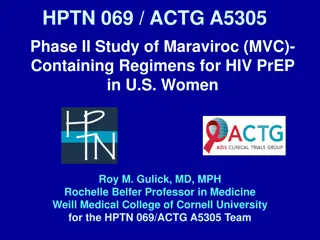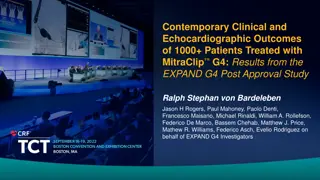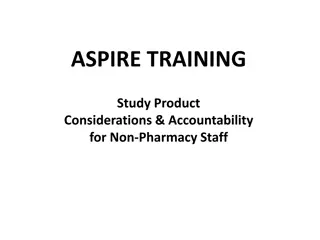ACEA study on ASEP
ACEA initiated a study on ASEP joined by Contracting Parties (France, Germany, Japan, The Netherlands). The study includes work packages focusing on ASEP achievements, impact on vehicle design and technology, type approval handling, and more. Literature reviews on ASEP development, vehicle annoyance, and citizen complaints are explored, along with manufacturer and press views on sound perception in vehicles.
Download Presentation

Please find below an Image/Link to download the presentation.
The content on the website is provided AS IS for your information and personal use only. It may not be sold, licensed, or shared on other websites without obtaining consent from the author.If you encounter any issues during the download, it is possible that the publisher has removed the file from their server.
You are allowed to download the files provided on this website for personal or commercial use, subject to the condition that they are used lawfully. All files are the property of their respective owners.
The content on the website is provided AS IS for your information and personal use only. It may not be sold, licensed, or shared on other websites without obtaining consent from the author.
E N D
Presentation Transcript
ACEA study on ASEP 16.09.2024 WP1 & WP2 Confidential Document
Study on ASEP Work Package 1 - Results ACEA initiated a study on ASEP, which was later joined by several Contracting Parties (France, Germany, Japan, The Netherlands) WP.1: Achievements by ASEP (as in force today) The study consists of two work packages WP.2: Monitoring of RD-ASEP WP.1, started from the following questions: Did ASEP affect vehicle design and technology? Did ASEP lead to a remarkable release of single vehicle annoyance in real traffic? How is ASEP handled during type approval? o o o The following work packages were carried out during WP1 WP1.1 Literature review, on the development of ASEP and its impact on the product design. WP1.2 Questionnaire survey, towards manufacturers and contracting parties WP1.3 Test campaign on vehicles, 8 vehicles (4 twins) tested o o o 2 Confidential Document ACEA/UTAC study on ASEP
Literature review : ASEP during development (2005-2009) Model-based approach OICA proposal F/D proposal Slope-Assessment Detecting non-linearities, cycle- beating, cheating. Based on linear sound behaviour. Combination of F/D and OICA proposals. Critics/limitations: Engineering method based on a linear regression determined individually per vehicle. Establishing limit curves based on fixed slopes. The engine speed, as only explicative variable, limits the gear ratios to k i (for limiting the influence of the rolling noise). Engine speed based. No Not-to-exceed limit (No worst-case). Slope-Assessment could allow noisier vehicles than R51.02. Not-To-Exceed approach Lurban-Assessment Ref. Sound Assessment Netherlands proposal Establishing limit curves. Preserving the benefits of R51.02. Defining a vehicle of concern using Lurban as metric. Method not based on a physical noise model but geometrically built from both the anchor point and a N-T-E point at the maximum engine speed. Operating conditions close to 61 km/h and 1.9 m/s . Classifying method empirically established from dataset. The assumptions make difficult to understand the physical noise behaviour of the vehicles. Dealing with the worst-case, but the slope could be artificially flat, especially for vehicles with high rated engine speed. 3 Confidential Document ACEA/UTAC study on ASEP
Literature review : Vehicle annoyance versus ASEP Administration s observation: citizens complaints (from environment groups) Major sources for citizen complaints Sound emitted by M1 cars is perceived as one source for annoyance, but less important compared to other sources. Administration s action: noise abatement for single events noises Installation of automated noise camera to monitor sound from passing vehicles Such monitoring can be used to gain an overview about nature, number and timing of any kind of noise events (sirens, horns, street sweepers, garbage trucks, modified vehicles, reckless driving, buses, trucks and more). Manufacturer view: satisfying customers expectation (stipulated by press reports) Many customers request a pleasant sound. Compromise is needed to serve customer and comply with regulations (especially ASEP). Press (motor vehicles magazine) observation: The sound of newer car models seem to be less emotional. Customers report that new cars were disappointing compared to previous models . Medusa Noise Monitor 4 Confidential Document ACEA/UTAC study on ASEP
Key findings from OEMs questionnaire 1. Most manufacturers apply the guidance of the GRB-68-03 voluntarily. Way of Data Analysis 2. Correlation between the PMR and the impact of the ASEP. 3. Most manufacturers of vehicles with low PMR are little impacted by ASEP. Answers to the questionnaire: Which components were impacted by ASEP? Do you follow the guidance of GRB-68-03? 4. Most manufacturers of low PMR vehicles consider ASEP too time-consuming with minimal impact. No,it is no mandatory 5. Most manufacturers of high PMR vehicles rate ASEP as being balanced regarding time consumption versus effort on sound reduction. Yes, but only on request Yes 6. ASEP has an impact, especially on exhaust system, ECU and TCU. 5 Confidential Document study on ASEP
Key findings from CPs questionnaire 1. The trend of citizens complaints seem to increase, which could be linked to more awareness of environmental noise issues (after Covid 19, with home office, ). 2. Vehicle sound is not systematically controlled in the frame of Regulation 2018/858 market surveillance (MaS). Only half of CPs answering to the questionnaire apply MaS for vehicle sound. 3. ASEP is rarely tested during Market Surveillance 4. Low assessment or information regarding the ASEP effectiveness in reducing single vehicle noise. In your opinion, has ASEP contributed to making noisy single vehicles quieter? Is ASEP an important tool for single vehicle noise abatement ? Conclusions: At least, the EU system enables multiple tools to enforcement for noise abatement A recommendation is to Systematically use the MaS Enforce in-use controls and strength Periodical Technical Inspection (PTI). YES NO DON'T KNOW YES NO DON'T KNOW 6 Confidential Document study on ASEP
Test campaign WP1 Test program: o Tests were performed according to UN R51.02, UN R51.03, ASEP and partly RD-ASEP based on the test program outlined by the IWG RD-ASEP in 2017/2018. o Eight vehicles (four twin pairs) were identified as potential candidates. o The term Twin vehicle refers to: - one approved under UN R51.02, and - the successor model approved under UN R51.03 (preferably stage 2). o Vehicle selection was based on press reports, the outcome of questionnaires, and availability. o Availability was a challenge as the target vehicles were high-powered and difficult to obtain therefore, data were also received from. - An authority research program conducted between 2018 and 2020 - Manufacturer type approval tests (witnessed by their technical service) Test completion was achieved in August 2024. o 7 Confidential Document study on ASEP
TWIN 1 Technical Background Information TWIN 1 OLD Model TWIN 1 NEW Model General Approval Information General Approval Information Model Year 2015 Model Year 2022 For this study UN R51.02 73 dB(A) Official Approval UN R51.02 73 dB(A) For this study UN R51.03 71 dB(A) Official Approval UN R51.03 70 dB(A) Tech. Data Value Unit Tech. Data Value Unit Engine 4 cylinder Petrol 1998 cc Engine 4 cylinder Petrol 1,798 cc Net Power Pn 201 kW Net Power Pn 221 kW Rated Engine Speed S 5500 1/min Rated Engine Speed S 8250 1/min Curb Mass mro 1545 kg Curb Mass mro 1569 kg PMR 143 kW/t PMR 141 kW/t Reference Point Front Reference Point Front Tyre Dimension 225/40 ZR18 92W Tyre Dimension 235/40 ZR18 91Y Max Vehicle Speed 254 km/h Max Vehicle Speed 255 km/h GEAR RATIOS CALCULATED PER RUN GEAR RATIOS CALCULATED PER RUN AVG i 9,6 1 15,7 2 21,6 3 29,1 4 35,0 5 43,0 6 AVG i 8,7 1 14,0 2 20,1 3 27,5 4 34,8 5 42,4 6 8 7 8 7 8 Confidential Document study on ASEP
TWIN 1: ASEP Slope-Assessment method TWIN 1 NEW Model TWIN 1 OLD Model ASEP Border Curve is based on UN R51.03 PHASE 1 ASEP Border Curve is based on UN R51.03 PHASE 2 Test runs under partial load and full load -3 dB Gear 5 and 6 are out of scope of ASEP Data Source: UTAC test data, 2024 Data Source: UTAC test data, 2024 FINDINGS: Old model is not affected by ASEP New model struggles more with the ASEP border curve created by a tailpipe resonance. However, especially for high engine revolutions shows much lower sound levels compared to the old model. CONCLUSIONS: Overall, the new model is about 3-5 dB quieter than the old model Quieter tyres - even with bigger size - and a quieter powertrain enable the change 9 Confidential Document study on ASEP
TWIN 1: Lurban-Assessment method TWIN 1 OLD Model TWIN 1 NEW Model FAIL FAIL Area with the resonance PASS PASS Data Source: UTAC test data, 2024 Data Source: UTAC test data, 2024 FINDINGS: Both vehicles (old and new) can pass the Lurban-Assessment The old model is closer to the Lurbanborder. For the new model, Lurban-Assessment indicates the area of sensitivity, but the vehicle can pass the test. Partial load run (not shown by this graphs) can be more critical compared to full load. CONCLUSIONS: Lurban-Assessment is more tolerant compared to the Slope- Assessment. 10 Confidential Document study on ASEP
TWIN 1: RD-ASEP comparison measurement / expectation TWIN 1 OLD Model TWIN 1 NEW Model FAIL FAIL PASS PASS Data Source: UTAC test data, 2024 Data Source: UTAC test data, 2024 FINDINGS: Both vehicles (old and new) fail RD-ASEP The new model could pass RD-ASEP, except of the resonance area. CONCLUSIONS: The question can be raised, whether a single resonance shall create a fail of the vehicle in type approval. The scope of ASEP should be to identify, if a vehicle is deviating from the type approval manner over a large driver usable range- from the expected sound level. 11 Confidential Document study on ASEP
TWIN 2 Technical Background Information TWIN 2 OLD Model TWIN 2 NEW Model General Approval Information General Approval Information Model Year 2011 Model Year 2017 For this study UN R51.02 69 dB(A) Official Approval UN R51.02 72.2 dB(A) For this study UN R51.03 73 dB(A) Official Approval UN R51.03 71 dB(A) Tech. Data Value Unit Tech. Data Value Unit Engine 8 cylinder Petrol 4 163 cc Engine 6 cylinder Petrol 2 894 cc Net Power Pn 331 kW Net Power Pn 331 kW Rated Engine Speed S 8250 1/min Rated Engine Speed S 6700 1/min Curb Mass mro 1954 kg Curb Mass mro 1860 kg PMR 169 kW/t PMR 178 kW/t Reference Point Front Reference Point Front Tyre Dimension 265/35 R19 98Y Tyre Dimension 275/30 R20 97Y Max Vehicle Speed 250 km/h Max Vehicle Speed 250 km/h GEAR RATIOS CALCULATED PER RUN GEAR RATIOS CALCULATED PER RUN AVG i 13,0 2 18,3 3 24,2 4 30,9 5 AVG i 12,5 2 18,7 3 22,9 4 30,1 5 39,2 6 1 6 7 8 12 1 7 8 Confidential Document study on ASEP
TWIN 2: ASEP Slope-Assessment method TWIN 2 OLD Model TWIN 2 NEW Model -5 dB ASEP Border Curve is based on UN R51.03 PHASE 1 ASEP Border Curve is based on UN R51.03 PHASE 2 Data Source: Manufacturer Data, 2023, inhouse testing, data check by UTAC Data Source: Manufacturer Data, 2023, inhouse testing, data check by UTAC FINDINGS: The old model can pass the ASEP test. The orange and brown points are higher gears, which are not in the focus of ASEP today. The new model is very different, given by a new engine. (V6 instead of V8), despite the wheel are bigger. CONCLUSIONS: The new model show is about 5 dB to 8 dB quieter especially towards higher engine speeds. 13 Confidential Document study on ASEP
TWIN 2: Lurban-Assessment method TWIN 2 OLD Model TWIN 2 NEW Model FAIL FAIL PASS PASS Data Source: Manufacturer Data, 2023, inhouse testing, data check by UTAC Data Source: Manufacturer Data, 2023, inhouse testing, data check by UTAC FINDINGS: Both vehicle comply with Lurban-Assessment. The new model is much below the ASEP border. CONCLUSIONS: Again, the Lurbanmethod is less demanding compared to the Slope -Assessment 14 Confidential Document study on ASEP
TWIN 2: RD-ASEP comparison Measurement / Expectation TWIN 2 OLD Model TWIN 2 NEW Model FAIL FAIL PASS PASS Data Source: Manufacturer Data, 2023, inhouse testing, data check by UTAC Data Source: Manufacturer Data, 2023, inhouse testing, data check by UTAC FINDINGS: The old model cannot pass RD-ASEP in low gear over a large range, while the new model could pass RD-ASEP. The new model has no difficulties in passing even RD- ASEP. CONCLUSIONS: RD-ASEP is more demanding compared to the current ASEP provisions. 15 Confidential Document study on ASEP
TWIN 3 Technical Background Information TWIN 3 OLD Model TWIN 3 NEW Model General Approval Information General Approval Information Model Year 2017 Model Year 2018 Facelift of OLD Model 74 dB(A) (Normal) 96 dB(A) (Sport) Official Approval UN R51.02 For this study UN R51.02 72 dB(A) Official Approval UN R51.03 70 dB(A) For this study UN R51.03 71 dB(A) Tech. Data Value Unit Tech. Data Value Unit Engine R5 Petrol 2480 cc Engine R5 Petrol 2480 cc Net Power Pn 294 kW Net Power Pn 294 kW Rated Engine Speed S 5850 1/min Rated Engine Speed S 7000 1/min Curb Mass mro 1476 kg Curb Mass mro 1548 kg PMR 199,2 kW/t PMR 189,9 kW/t Transmission AT 6 Gears Transmission AT 7 Gears Reference Point Front Reference Point Front Tyre Dimension 245/35 R 19 (Front) 255/30 R20 (Rear) Tyre Dimension Max Vehicle Speed 250 km/h Max Vehicle Speed 250 km/h GEAR RATIOS CALCULATED PER RUN GEAR RATIOS CALCULATED PER RUN 16 AVG i 14,6 2 21,5 3 29,9 4 AVG i 14,2 2 21,3 3 29,3 4 37,5 5 Confidential Document study on ASEP 1 5 6 7 8 1 6 7 8
TWIN 3: ASEP : Slope-Assessment method TWIN 3 OLD Model TWIN 3 NEW Model -10 dB ASEP Border Curve is based on UN R51.03 PHASE 2 ASEP Border Curve is based on UN R51.03 PHASE 1 Data Source: German UBA, 2020; Forschungskennzahl 3717 54 103 0 FB000238 berpr fung der Ger uschemissionen von Motorr dern im realen Verkehr Abschlussbericht Data Source: Manufacturer Data, 2018, gained during vehicle type approval; witnessed by technical service FINDINGS: The old model does not comply with the ASEP Slope- Assessment (and was not forced to comply with it) The new model was approved under UN R51.03 phase 2 perspective and consequently complies with ASEP. The new model is 10 dB quieter than the old model. CONCLUSIONS: Both models comply with the UN R51.03 phase 3 limit of 71 dB Only Annex 3 Provisions would not have forced any re- design. The re-design of the vehicle was stipulated by the ASEP provisions of UN R51.03. 17 Confidential Document study on ASEP
TWIN 3: Lurban-Assessment method TWIN 3 OLD Model TWIN 3 NEW Model FAIL FAIL PASS PASS Data Source: German UBA, 2020; Forschungskennzahl 3717 54 103 0 FB000238 berpr fung der Ger uschemissionen von Motorr dern im realen Verkehr Abschlussbericht Data Source: Manufacturer Data, 2018, gained during vehicle type approval; witnessed by technical service FINDINGS: Same finding, the old model does not pass the Lurban- Assessment. But, more pass-points compared to the Slope- Assessment CONCLUSIONS: Same conclusions as for the Slope-Assessment from the previous slide. Lurban is less stringent compared to the Slope-Assessment 18 Confidential Document study on ASEP
TWIN 3: RD-ASEP comparison Measurement / Expectation TWIN 3 OLD Model TWIN 3 NEW Model FAIL FAIL PASS PASS Data Source: German UBA, 2020; Forschungskennzahl 3717 54 103 0 FB000238 berpr fung der Ger uschemissionen von Motorr dern im realen Verkehr Abschlussbericht Data Source: Manufacturer Data, 2018, gained during vehicle type approval; witnessed by technical service CONCLUSIONS: Here again, RD-ASEP is most stringent to the vehicle sound performance, compared to the existing ASEP evaluation methods FINDINGS: Only few tested points of the old model can comply with RD-ASEP (5 points) 19 Confidential Document study on ASEP
TWIN 4 Technical Background Information TWIN 4 OLD Model TWIN 4 NEW Model General Approval Information General Approval Information Model Year (2016 R51.02) - 2019 Model Year 2020 74 dB(A) (AT-D) 90 dB(A) (MT-2/3) Official Approval UN R51.02 For this study UN R51.02 67 dB(A) Official Approval UN R51.03 67 dB(A) For this study UN R51.03 phase 1 72 dB(A) Tech. Data Value Unit Tech. Data Value Unit Engine R4 Petrol 1368 cc Engine Electric cc Net Power Pn 132 kW Net Power Pn 114 kW Rated Engine Speed S 5500 1/min Rated Engine Speed S n.a. 1/min Curb Mass mro 1045 kg Curb Mass mro 1335 kg PMR 126 kW/t PMR 85 kW/t Transmission 5 Gears Automized MT Transmission 1 Gear AT Reference Point Front Reference Point Front Tyre Dimension Tyre Dimension Max Vehicle Speed 155 km/h Max Vehicle Speed 225 km/h GEAR RATIOS CALCULATED PER RUN 20 AVG i 8,8 1 14,5 2 21,3 3 28,1 4 37,1 5 Confidential Document study on ASEP 6 7 8
TWIN 4: ASEP : Slope-Assessment method TWIN 4 OLD Model TWIN 4 NEW Model ASEP Border Curve is based on UN R51.03 PHASE 3 D ASEP Border Curve is based on UN R51.03 PHASE 1 Data Source: UTAC Measurements Data Source: UTAC Measurements validation FINDINGS: The old model was approved under UN R51.02 in D. could have passed UN R51.03 phase 1 (due to low cruise test results, only tested in 4th gear manual) and it roughly complies with ASEP. Old model, would not meet the phase 3 limits as currently enforced. The new model is not subject to ASEP as it is an electric vehicle. However, if it were subjected to ASEP, it would not comply with the phase 3 limits. CONCLUSIONS: Although the new model is notably quieter compared to the old model, it does not comply with ASEP phase 3 limits. The artificially added sound is detected by the existing ASEP model. 21 Confidential Document study on ASEP
TWIN 4: Lurban-Assessment method TWIN 4 OLD Model TWIN 4 NEW Model Full Load Full Load FAIL FAIL PASS PASS Part Load Part Load No Load No Load Data Source: UTAC Measurement validation Data Source: UTAC Measurements CONCLUSIONS: FINDINGS: Lurbanand Slope assessment are very similar in this case for the old model, in both cases are near to fail. The new model passes the Lurbanassessment. Extra loud points mentioned on previous page cannot be evaluated using Lurbanassessment because all these points have accelerations below aurban. Although the old model fails the Lurbanmethod, the method remains less demanding compared to the slope assessment method The Lurbanmethod cannot assess artificially added sounds where there are no accelerations, as the algorithm does not support this type of assessment and would fail if attempted 22 Confidential Document study on ASEP
TWIN 4: RD-ASEP comparison Measurement / Expectation TWIN 4 OLD Model TWIN 4 NEW Model Full Load FAIL FAIL Part Load PASS No Load PASS Data Source: UTAC Measurements Data Source: UTAC Measurements CONCLUSIONS: The new model is an electric vehicle with added sound in addition to the provisions of UN R138. FINDINGS: The TWIN-4 old model mostly fails to meet all expected sound levels (the graph shows full load only). The new model can easily pass, except where the artificially added sound produces excessive noise. Overall, the sound level of the new model is 10 dB to 15 dB lower, even with the use of this artificial sound. Where excessive sound has been added, the RD-ASEP model detects it, and the vehicle fails to meet the expected sound levels. 23 Confidential Document study on ASEP
SUMMARY Literature Review: Reports on real-world single-event noises show that vehicles subject to UN R51.03 ASEP contribute only a limited share to the overall problem. Press releases indicate that newer models have less thrilling sound compared to previous models. Questionnaire: Manufacturers report that ASEP impacts especially high-performance vehicles, requiring redesigns mainly of the exhaust system, ECU, and TCU. Most manufacturers apply the guidance of GRB-68-03 voluntarily. Contracting Parties confirm that noise from single vehicles is a pressing concern for citizens. However, for Market Surveillance exterior noise of vehicles is not systematically applied. and ASEP is rarely checked. Test Campaign: For all investigated TWIN, the newer models were substantially quieter compared to their previous model, even though the older models already complied with UN R51.03 Annex 3 limitsT The progress in sound reduction was driven by the enforcement of UN R51.03 limits (from phase 1 to phase 3) in combination with ASEP as a package Slope-Assessment is generally more stringent compared to Lurban-Assessment. The upcoming RD-ASEP (status as of the 2023/24 monitoring phase draft) will be more stringent compared to any current ASEP provisions. 24 Confidential Document study on ASEP
CONCLUSIONS Answers by UTAC, based on the research, questionnaire analysis and test campaign: Questions asked for WP.1 YES, all new models tested were substantially quieter compared to the previous model, typically 5dB to 10dB, in some cases even more Did ASEP affect product designs? SoC only ASEP compliance, by statement of compliance (SoC) based on in-house tests, or witnessed tests together with the authority. Inhouse test How is ASEP handled during type approval ? Witness tests NO, complains by citizens have not been reduced; less than 30% of the fleet are UN R51.03 vehicles (70% of the vehicles were never tested by ASEP), so older vehicles, other noise sources, or aspects not subject to UN R51 play a role. Did ASEP lead to a remarkable release of single vehicle annoyance in real traffic? 25 driving bahaviour, manipluation, maintenance, Confidential Document study on ASEP
Study on ASEP Final Conclusions The study investigated in WP.1 the impact of ASEP on current vehicle technology. Although only a limited number of vehicles were tested perhaps too few for such a general conclusion the result is clear. The ATE EL study from 2021, conducted on behalf of ACEA, already indicated that progress in technology for M1 vehicles was greatest for high-performance vehicles (class M1-c). ATE EL study on behalf of ACEA, August 2021 Conclusion in one sentence can be expressed as: UN R51.03, as a package of Annex 3 testing with limits in three phases, along with the specifications on ASEP (paragraph 6.2.3 of the main body plus Annex 7), has delivered significant progress for high-performance vehicles. 26 Confidential Document ACEA/UTAC study on ASEP
ACEA study on RD-ASEP data base WP2 Confidential Document
Study on ASEP WP.2 Analysis of the data collected to date Around 800 files were expected when the program started, but only 451 have been collected 28 Confidential Document ACEA/UTAC study on ASEP
Study on ASEP WP.2 Analysis of the data collected to date Type_approval vs Files received 200 186 180 160 140 120 95 100 80 60 54 54 60 47 34 40 31 30 27 18 17 16 20 13 12 10 8 5 5 3 2 2 1 1 1 1 0 0 0 0 e13 e9 e4 e5 e1 e2 e8 e20 e6 e32 e3 e49 e7 e24 e27 e25 e19 e11 Japan Type_Approval Received 29 Confidential Document ACEA/UTAC study on ASEP
Study on ASEP WP.2 Analysis of the data collected to date Categ veh CONFORMITY CHECK 3% 4% 97% 96% M1 N1 Approved Failed 30 Confidential Document ACEA/UTAC study on ASEP
Study on ASEP WP.2 Analysis of the data collected to date PMR BY CATEG_VEH Total M1 N1 451 431 303 283 66 66 41 41 41 41 20 20 0 0 0 PMR <120 PMR >200 TOTAL 120 < PMR 160 160 < PMR 200 31 Confidential Document ACEA/UTAC study on ASEP
Study on ASEP WP.2 Analysis of the data collected to date ENGINE TYPE ENGINE TYPE 300 ICE HEV (AVAS/SES) HEV (NO AVAS) EV (AVAS/SES) EV (AVAS) OTHER 258 2% 5% 250 200 15% 150 93 100 57% 66 21% 50 24 10 0 0 ICE HEV HEV (NO AVAS) EV (AVAS/SES) EV (AVAS) OTHER (AVAS/SES) 32 Confidential Document ACEA/UTAC study on ASEP
Study on ASEP WP.2 Analysis of the data collected to date TRANSMISSION TYPE AT MT CVT OTHER NONE 2%2% 6% 13% 77% 33 Confidential Document ACEA/UTAC study on ASEP
Study on ASEP WP.2 Analysis of the data collected to date 34 Confidential Document ACEA/UTAC study on ASEP
Study on ASEP WP.2 Analysis of the data collected to date 35 Confidential Document ACEA/UTAC study on ASEP
Study on ASEP WP.2 Analysis of the data collected to date How to check the number of missing files still to arrive? Communication from type approval authorities to their TS representative? Some CP sent only mandatory 451 including extension. Representative database? 75% of all date are coming from two type approval authorities (not extensions) Extension of the collection period until the end of October. Extensions of the actual mandatory RD-ASEP testing period? Conclusions and possible RD-ASEP Method improvements once collection is finish 36 Confidential Document ACEA/UTAC study on ASEP
Study on ASEP WP.2 Analysis of the data collected to date How can we check the number of missing files that are yet to arrive? Possible communication from type approval authorities to their TS representatives. 62% of all data are coming from two type approval authorities. (mandatory and voluntary files) There has been an extension of the collection period until the end of October. Can we extend the current mandatory RD-ASEP testing period if the group considers we do not have enough data to cover all vehicle technologies? Conclusions and potential improvements to the RD-ASEP method can be drawn once the collection is complete. 37 Confidential Document ACEA/UTAC study on ASEP
www.utac.com www.utac.com miguel.cruz@utac.com Confidential Document
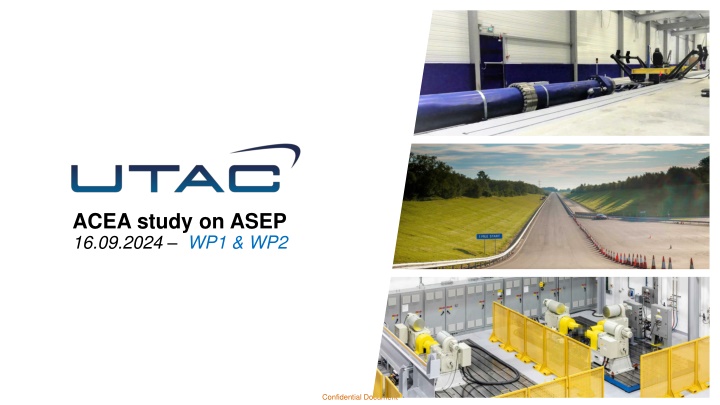


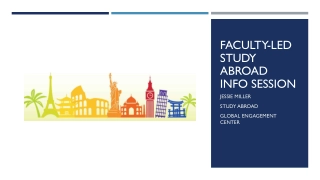

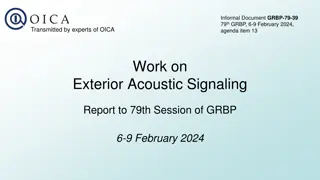
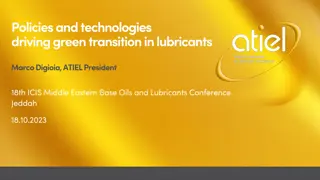

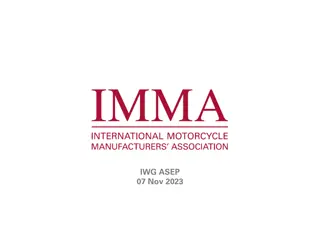
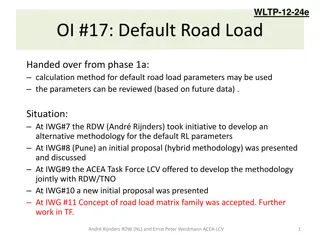
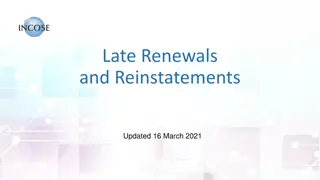


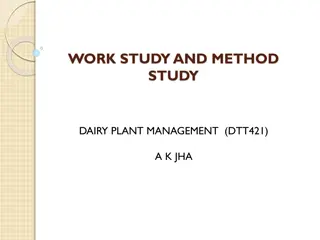
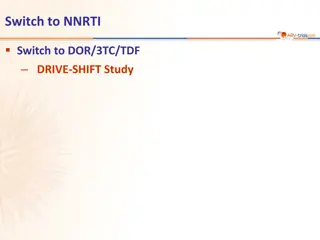

![[Insert Study Name] Study Webinar: Engaging Participants for Research Progress](/thumb/168084/insert-study-name-study-webinar-engaging-participants-for-research-progress.jpg)

